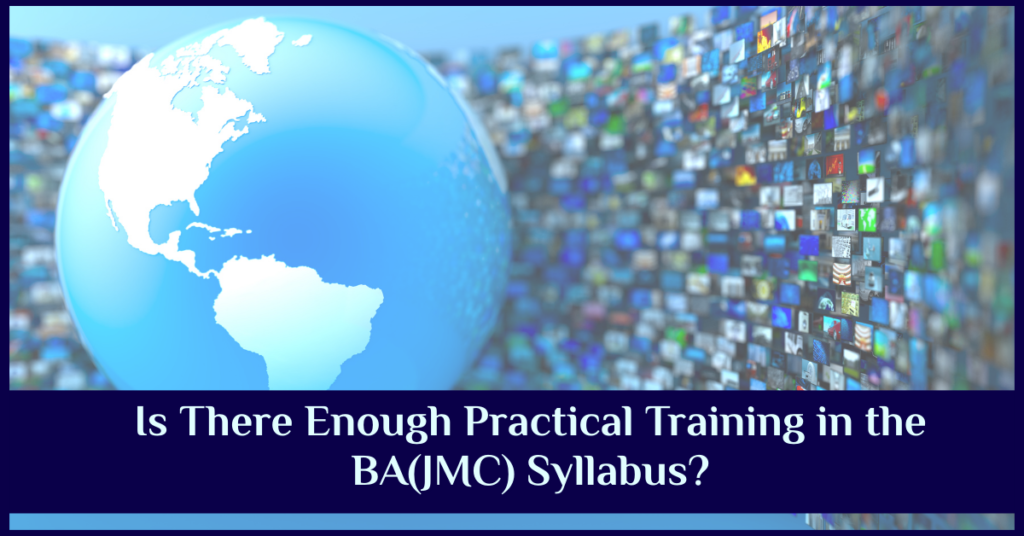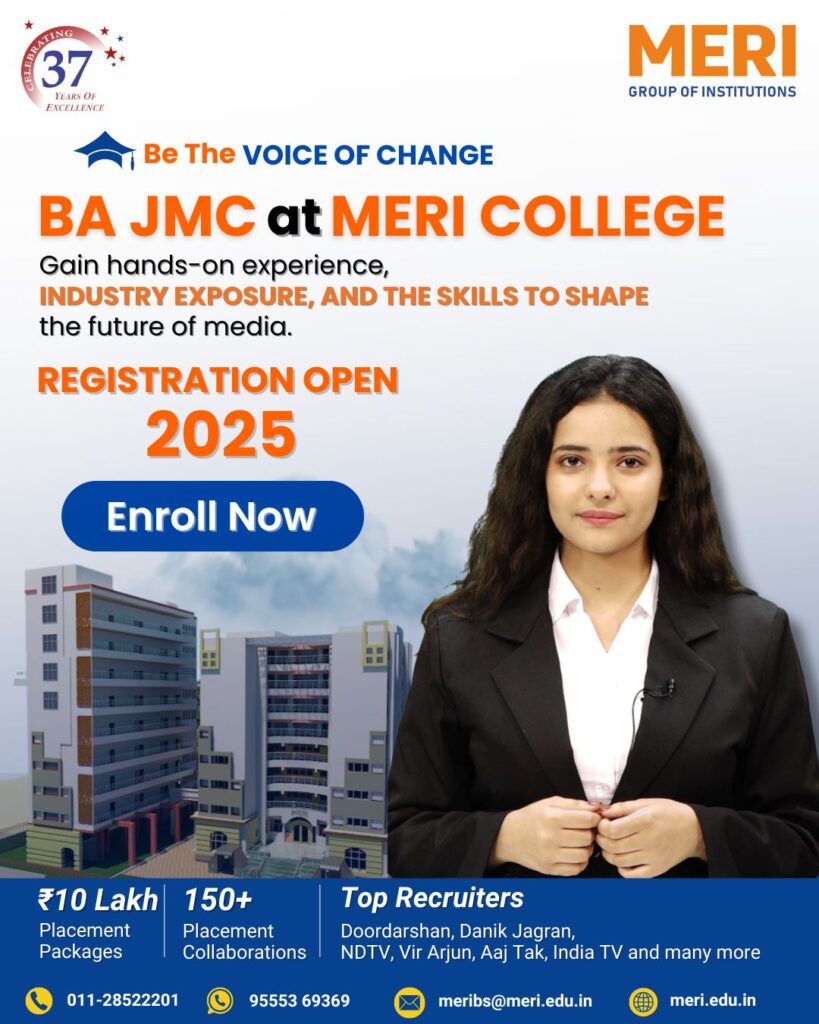The aroma of fresh coffee drifted through the media lab of a well-known college in Janakpuri, New Delhi. The room was lined with DSLR cameras, sturdy tripods, teleprompters, and advanced editing consoles. Aarav, a first-year BA(JMC) student, had enrolled with dreams of becoming a powerful storyteller- someone who could weave words, images, and truth into compelling narratives.
Yet, as he stood among the high-end equipment, one thought nagged at him:
“Will this course truly prepare me to work confidently in a newsroom, a production studio, or on a film set?”
It’s a question many media students quietly ask themselves. And it’s a valid one — because media education isn’t just about understanding theory, it’s about applying it in real situations. As veteran journalist Christiane Amanpour once remarked:
“We do not simply sit in front of a camera. We go to where the story is.”
A good BA(JMC) programme, like any strong Journalism and mass communication course, should follow the same principle- taking students to where the action happens, whether that’s a buzzing TV studio, a hectic film shoot, or a grassroots community project.
When the Classroom Steps Into the Real World
In Aarav’s first semester, his class studied the basics — news writing, ethics, and media concepts. But instead of confining learning to slideshows, the professor sent them to cover the annual DilliHaat craft fair.
The task was more than just “observe and report.” Students had to:
- Conduct interviews with at least three artisans
- Capture professional-quality photographs
- Write a human-interest piece ready for publication
Their stories were uploaded to the department’s official blog, reaching alumni and local media professionals in Janakpuri. This is how real-world experience quietly blends into academic work- making students confident by connecting lessons to live events.
This balance of theory and practice is what defines a quality Journalism and mass communication course.
The Industry’s Growing Expectations
The media field today moves at breakneck speed. Employers want professionals who can:
- Tweet live updates from an event
- Record and edit a podcast episode
- Shoot and produce a 60-second news clip
- Draft a sharp press release — all in one workday
As Pulitzer Prize–winning journalist Gene Weingarten once said: “In the modern newsroom, versatility is the most precious currency.”
Courses that include workshops, field assignments, and lab-based training equip students for this environment. That’s why choosing a Journalism and mass communication course with strong digital integration is crucial. A syllabus that adapts to the industry’s digital shift ensures graduates leave with not just a certificate, but a portfolio ready for interviews.

Hands-On Learning in Action
By the second year, Aarav’s class had moved into television production. They didn’t just watch news bulletins — they produced them from scratch, an experience that every Journalism and mass communication course should provide.
Students rotated through every key role:
- Anchor — delivering news clearly and confidently
- Camera Operator — framing and focusing shots
- Lighting Director — setting the perfect exposure
- Director — managing the control room flow
- Editor — piecing together the final broadcast
Guest speakers added another layer. A senior producer from India TV broke down how political debate shows are crafted for engagement, while a documentary filmmaker revealed how editing choices can change the emotional weight of a story.
Industry visits took students beyond tourist-style tours. They shadowed professionals at AajTak, TV9 Bharatvarsh, and NDTV, watching live countdowns and learning the rhythms of a real newsroom.
From Student to Content Creator
By the final year, Aarav was no longer just absorbing lessons – he was creating. A digital media module replaced a traditional exam with a live project: running a social media campaign for a local NGO in Janakpuri.
Students managed every aspect:
- Branding — creating the logo and posters
- Video Production — scripting, shooting, and editing clips
- Analytics — tracking engagement and tweaking strategy
The campaign succeeded in raising awareness for children’s education, attracted donors, and even earned a mention in the Hindustan Times metro section. Such projects double as portfolio pieces, which often matter more to recruiters than grades. These projects also demonstrate how a Journalism and mass communication course can directly translate into employable skills.
Mentorship in a Journalism and Mass Communication Course
Strong mentorship is the backbone of hands-on learning. Aarav’s advertising professor, who had managed campaigns for Hindustan Unilever, turned classroom work into simulated agency pitches. His media law lecturer, a former The Hindu correspondent, shared real-life experiences from court reporting and press freedom cases , showing how a Journalism and mass communication course is enriched by faculty with industry backgrounds.
As Nelson Poynter once observed:
“The best teacher for a reporter is the streets. The second best is a reporter.”
Testing Skills Through Internships
Every BA(JMC) curriculum needs internships. At MERI Janakpuri, students benefit from access to top media organisations like:
Some even secure internships at Reuters, Associated Press, or independent film studios. Aarav’s stint at Zee News’ Janakpuri bureau was a reality check — covering rallies with just a phone one day, editing social media clips under tight deadlines the next. The unplanned challenges — equipment issues, unpredictable sources, script changes — were his most valuable lessons.
Internships remain one of the strongest pillars of a Journalism and mass communication course, bridging classroom learning with the unpredictability of real assignments.
Final Semester: The Professional Shift
By the last semester, Aarav was mentoring juniors, producing his own short documentary, and handling media coverage for the college’s cultural fest.
He graduated with:
- A solid portfolio of articles, videos, and campaigns
- Industry connections built through lectures and internships
- Technical skills in cameras, editing software, and live production
By this stage, students truly understand the value of their Journalism and Mass Communication course, as it transforms into a professional launchpad
Why This Matters to Future Students
For those aiming to work in journalism, filmmaking, PR, or digital strategy, BA(JMC) can be a strong launchpad — but only if the syllabus stays closely aligned with industry needs. That means:
- Including real assignments in every semester
- Partnering with NGOs and businesses
- Training students for multi-platform storytelling
- Giving early access to equipment and studios
- Building a strong alumni network
These elements distinguish an excellent Journalism and mass communication course from one that is merely academic
As war photographer Robert Capa famously said:
“If your pictures aren’t good enough, you’re not close enough.”
The same applies to media training — if the learning isn’t close to real industry work, it’s simply not enough.
For many graduates from MERI, Janakpuri, New Delhi— BA(JMC) became more than an academic journey. It was a rehearsal for the real stage, where lights burn bright, deadlines are unforgiving, and every frame, every sound bite, and every story counts, the true hallmark of a Journalism and mass communication course that prepares you for the industry.
Frequently Asked Questions (FAQ)
Yes. Start early with blogs, YouTube channels, or class projects.
Absolutely – it’s near major TV channels, radio stations, and agencies, making internships more accessible
Be proactive. Take challenging assignments, seek feedback, and work as if your output is going public.
Video editing (Adobe Premiere Pro, Final Cut Pro), social media analytics, mobile journalism, and basic design tools like Canva or Photoshop.
Extremely. Many jobs come through contacts made during events, guest lectures, and alumni interactions.
Previous Article



